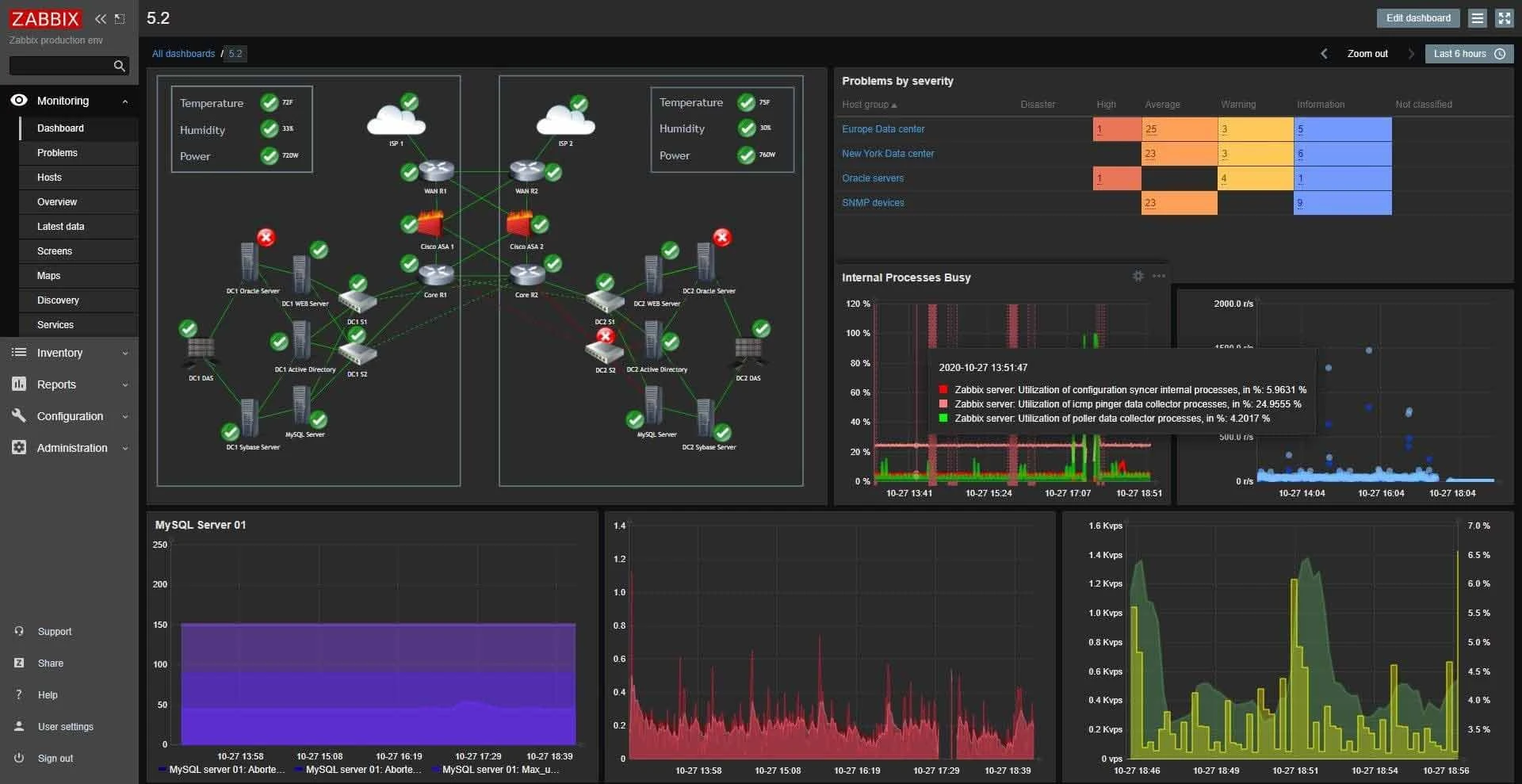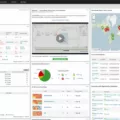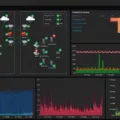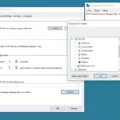Network monitoring tools are essential for maintaining the health and performance of networks. These tools enable network teams to ensure the availability, stability, and security of their networks. By proactively monitoring the availability and performance of their networks, organizations can prevent costly downtime, improve customer satisfaction, and maximize productivity.
One of the most popular network monitoring tools is Atera. This cloud-based platform offers a comprehensive suite of features for managing networks in real-time. It provides detailed information about devices on the network, including device uptime, bandwidth utilization, traffic patterns, and more. Additionally, Atera offers advanced analytics tools that allow users to identify trends in network performance over time.
SolarWinds Network Performance Monitor (NPM) is another useful tool for network monitoring. NPM provides detailed insights into the performance of routers and switches as well as wireless access points and other components on the network. Additionally, NPM offers an easy-to-use dashboard with customizable views so users can quickly identify potential issues or areas that need improvement.
Datadog is another top choice when it comes to network monitoring tools. This cloud-based platform provides powerful visualization capabilities that make it easy to see how different components are performing on the network. Datadog also has a range of alerting capabilities so users can stay informed about any changes or issues that may arise with their networks in real-time.
Obkio is a great option for those looking for a more cost-effective solution for network monitoring needs. Obkio’s advanced analytics capabilities allow users to track bandwidth consumption as well as latency levels on their networks over time. Additionally, Obkio offers customizable dashboards so users can easily view key metrics at a glance and take action when needed.
ManageEngine OpManager is another popular option when it comes to choosing a tool for managing your networks efficiently and effectively. OpManager provides detailed insights into several aspects of your networks such as device uptime, bandwidth utilization, traffic patterns, and more with its easy-to-use dashboard interface. Additionally, OpManager allows users to set up custom alerts so they can stay informed about any changes or issues that may arise with their networks in real-time.
Finally, Site24x7 Network Monitoring is an excellent choice if you’re looking for an all-in-one solution for managing your networks from anywhere in the world at any time of day or night! Site24x7 provides comprehensive visibility into your entire IT infrastructure from one unified dashboard along with powerful analytics tools that allow you to drill down into specific aspects of your network such as latency levels or CPU usage across different devices on the same LAN/WAN segment among others! In addition, Site24x7’s built-in alerting system allows you to stay informed whenever something goes wrong within your IT environment so you can act quickly before any major damage occurs!
Overall these five options provide comprehensive solutions that make it easier than ever before to monitor your entire IT infrastructure without having to deploy expensive hardware or software solutions across multiple locations! Whether you’re looking for simple availability monitoring or more complex analysis capabilities these five options should have everything you need in order to keep your business running smoothly without interruption!

The Benefits of Network Monitoring Tools
Network monitoring tools are essential for keeping a network running smoothly and efficiently. They allow for the tracking, analysis, and reporting of the availability, health, and performance of networks. These tools help identify potential issues with hardware components, interfaces, virtual environments, storage devices, and more. By monitoring network performance in real time, network administrators can quickly diagnose problems before they become serious issues. Additionally, these tools provide useful data that can be used to improve the overall performance and security of a network. Network monitoring tools are invaluable for ensuring that networks remain reliable and secure.
Identifying the Best Tool for Network Monitoring
The best tool for network monitoring depends on the size and needs of your network. For small networks, Atera is a good option as it provides automated monitoring, remote access, and patch management. For larger networks, SolarWinds Network Performance Monitor is an excellent choice as it offers comprehensive monitoring of servers, applications, virtualization environments, and more. Datadog is also a powerful tool with its ability to monitor cloud-based systems and applications in addition to traditional networks. Obkio is another great option that offers real-time performance metrics and automated alerts. ManageEngine OpManager provides an all-in-one solution with monitoring, reporting, and alerting capabilities. Finally, Site24x7 Network Monitoring provides detailed insights into network availability, latency, and throughput for complete visibility into your network.
The Most Popular Network Monitoring Program
The most popular network monitoring program is Dynatrace. Dynatrace is an all-in-one solution for performance monitoring and anomaly detection across the entire application stack, from the edge to the cloud. It provides detailed insights into user behavior, application performance, infrastructure health, and more. With its advanced analytics capabilities, Dynatrace helps organizations identify and troubleshoot problems quickly and accurately. It also offers features like distributed tracing, automated root cause analysis, and real-time alerting. Additionally, Dynatrace provides comprehensive visibility into application dependencies across multiple components in the IT environment. This makes it easier for teams to identify issues faster and ensure optimal performance for their applications.
Categories of Network Monitoring
Network monitoring is the process of managing and monitoring computer networks to ensure optimal performance and reliability. There are four key categories of network monitoring: Availability Monitoring, Configuration Monitoring, Performance Monitoring, and Cloud Infrastructure Monitoring.
Availability Monitoring allows network teams to quickly detect if a device or service is down or not responding so that they can take appropriate action. This form of monitoring also helps to identify any potential disruptions to service that could lead to downtime.
Configuration Monitoring involves tracking changes in the configuration settings of a network device. This type of monitoring can help detect any misconfigurations that may cause unexpected behavior or system outages. It also helps identify areas where the performance of a device could be improved.
Performance Monitoring enables network teams to track the amount of data being transferred over a network, as well as pinpoint any bottlenecks or other issues that may be causing slowdowns in performance. This type of monitoring also allows teams to compare their current network performance with previous metrics to determine whether changes need to be made for optimization purposes.
Cloud Infrastructure Monitoring is an important part of managing cloud-based systems, as it provides visibility into the health and availability of applications and services hosted in the cloud environment. This type of monitoring helps ensure proper functioning by alerting teams when critical issues arise within the cloud environment so that they can take appropriate action for remediation efforts.
Is Wireshark a Network Monitoring Tool?
Wireshark is a network protocol analyzer, not a network monitoring tool. It captures packets from a network connection and decodes them to uncover their secrets, allowing users to understand the data that’s traveling through their networks. By capturing and analyzing these packets, Wireshark can provide insight into the performance of your network and reveal potential security vulnerabilities. While it does not provide real-time monitoring capabilities like most network monitoring tools do, Wireshark’s ability to capture and analyze past traffic can be invaluable for troubleshooting any performance or security issues with your network.
Monitoring Tools
The three basic tools for monitoring are:
1. Network Monitoring Tools: These help to detect, diagnose and resolve network-related issues by providing real-time visibility into the performance of the network. Examples include SolarWinds Network Performance Monitor and Nagios Core.
2. Application Performance Monitoring Tools: This help to monitor the performance of applications and services in real time. Examples include AppDynamics and Datadog APM.
3. Server Monitoring Tools: These tools provide real-time visibility into server performance, including memory utilization, CPU utilization, network bandwidth, etc., so that any potential problems can be identified quickly and resolved promptly. Examples include Splunk Enterprise and Zabbix.
Monitoring an Entire Network
Monitoring your entire network can be a straightforward task. All you need to do is access your router’s settings page. From there, you can view all of the devices connected to your network, including their IP addresses. To do this, type your router’s IP address into a web browser and sign in. You may have to look for a Status or Network Monitor section on the router, depending on the type of router you have. Once you find this section, you should be able to see all of the devices connected to your network and their respective IP addresses.
Monitoring Everything on a Network
Monitoring your network is an important step to ensure that it is secure and running efficiently. To view everything on your network, you will need to access your router’s web-based administration page.
First, open your web browser and enter the IP address of your router. This can typically be found on a label on the back or bottom of the router. Once you have accessed the administration page, locate the “Device List” section. This section will show all of the devices connected to your network as well as their respective IP addresses. You can then view each device’s status and bandwidth usage by selecting them from this list.
You may also be able to monitor other aspects of your network such as traffic statistics or security settings in this same area. The exact options available will vary depending on your router model, so it is important to refer to the manufacturer’s documentation for detailed instructions on how to use these features.
Does Windows Have a Network Monitoring Tool?
Yes, Windows has a network monitoring tool called Windows Network Monitor (NetMon). This tool is a network analyzer that can capture and analyze network traffic. It offers various features that allow you to see the details of the data being sent across your network, including source and destination IP addresses, port numbers, packet types, and more. It also provides advanced filtering capabilities so you can easily focus on the data you are interested in. Additionally, NetMon can be used to troubleshoot network issues, detect malicious activity, and monitor performance.
Methods of Network Monitoring
The two primary methods used for network monitoring are SNMP (Simple Network Management Protocol) and WMI (Windows Management Instrumentation). SNMP is a widely used protocol for monitoring and managing network devices. It enables the communication between managed devices (e.g routers, switches, servers) and network management systems. WMI is a Microsoft-specific protocol that allows administrators to monitor and manage Windows-based systems. It provides access to data about system performance, hardware configuration, user accounts, processes, services, and other elements of the Windows operating system. Both SNMP and WMI are important tools for keeping networks running smoothly by providing visibility into their status and performance.
Conclusion
In conclusion, network monitoring tools are essential to ensure the smooth functioning of any network. They help monitor the availability, health, and performance of networking hardware and interfaces, storage devices, virtual environment, and other components. There are a variety of network monitoring tools available in the market that range from simple availability monitoring to configuration and performance monitoring. These tools can provide valuable insights regarding the state of a network which can help make informed decisions about its maintenance and scalability. Ultimately, using a reliable network monitoring tool is essential for any business or organization that relies on an efficient IT infrastructure.








